Fish (Curiosité)
Species Summary for
Centropogon AustralisFortescue![]()
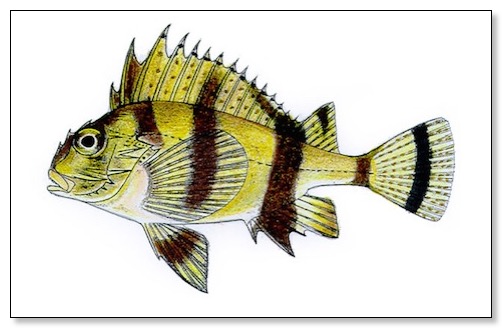
pencil-color illustration based on actual specimen.
by Yau, Bernard - 28.07.2000 
Locality: Gretas Reef
Date: 2006-12-20
http://fishbase.org/Photos/PicturesSummary.php?ID=6384&what=species
Australian Museum![]()
Fortescue, Centropogon australis (White, 1790) - Australian Museum
ANIMAL SPECIES:
Fortescue, Centropogon australis (White, 1790)
The Fortescue has a brown to white body with dark brown to black bars. It has two large spines on either side of the head that can be projected sideways when the fish is disturbed. The first dorsal fin has 16 strong spines that are capable of inflicting a very painful sting.
Standard Common Name
Fortescue
Identification
The Fortescue has a brown to white body with dark brown to black bars. It has two large spines on either side of the head that can be projected sideways when the fish is disturbed.
Size range
The species grows to 14 cm in length.
Similar Species
The Fortescue looks similar to the Soldier. Click on the link to the Soldier fact sheet on the right to find out how to tell them apart.
Distribution
The Fortescue is endemic to Australia. It occurs in temperate marine waters from southern Queensland to eastern Victoria.
The map below shows the Australian distribution of the species based on public sightings and specimens in Australian Museums. Source: Atlas of Living Australia.

Distribution by collection data
Ozcam map of Fortescue specimens in the Australian Museums.
WHAT DOES THIS MEAN?
Habitat
It lives in estuaries and bays to a depth of 30 m.
Other behaviours and adaptations
Divers often see Fortescues, sometimes in large numbers, resting motionless on the bottom.
Danger to humans and first aid
The16 strong dorsal fin spines are capable of inflicting a very painful sting. The pain of the sting can be eased by immersion in hot (not scalding!) water.
Classification
Species: australis
Genus: Centropogon
Family: Tetrarogidae
Order: Scorpaeniformes
Class: Actinopterygii
Subphylum: Vertebrata
Phylum: Chordata
Kingdom: Animalia
WHAT DOES THIS MEAN?
References
- Edgar, G.J. 1997. Australian Marine Life: the plants and animals of temperate waters. Reed Books. Pp. 544.
- Hoese, D.F., Bray, D.J., Paxton, J.R. & G.R. Allen. 2006. Fishes. In Beesley, P.L. & A. Wells. (eds) Zoological Catalogue of Australia. Volume 35. ABRS & CSIRO Publishing: Australia. parts 1-3, pages 1-2178.
- Hutchins, B. & R. Swainston. 1986. Sea Fishes of Southern Australia. Complete Field Guide for Anglers and Divers. Swainston Publishing. Pp. 180.
- Kuiter, R.H. 1996. Guide to Sea Fishes of Australia. New Holland. Pp. 433.
- Kuiter, R.H. 2000. Coastal Fishes of South-eastern Australia. Gary Allen. Pp. 437.
- Poss, S.G. in Gomon, M.F., Glover, C.J.M. & R.H. Kuiter (Eds). 1994. The Fishes of Australia's South Coast. State Print, Adelaide. Pp. 992.
- Underhill, D. 2010. Australia's Dangerous Creatures. Reader's Digest. Pp. 368.

A Fortescue at Shiprock, Port Hacking - Australian Museum
Photographer: Erik Schlögl © Erik Schlögl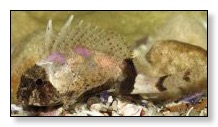
Fortescue, Centropogon australis View full size
Photographer: Aaron Payne © Aaron Payne
ww.amownline.net.au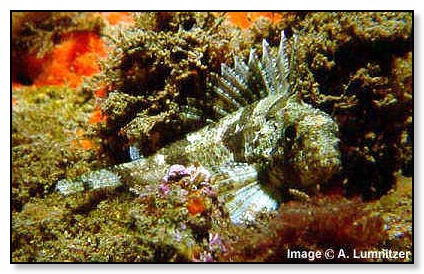
A Fortescue at a depth of 6m, La Perouse, Sydney, New South Wales, December, 1998.
Copyright © 1998 - 2005, australian museum online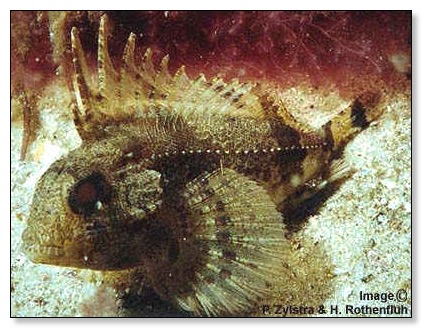
A Fortescue at a depth of 5m, Fly Point, Nelson Bay, New South Wales.
Copyright © 1998 - 2005, australian museum online
| A Taxonomic Summary of Australian Freshwater Fish |

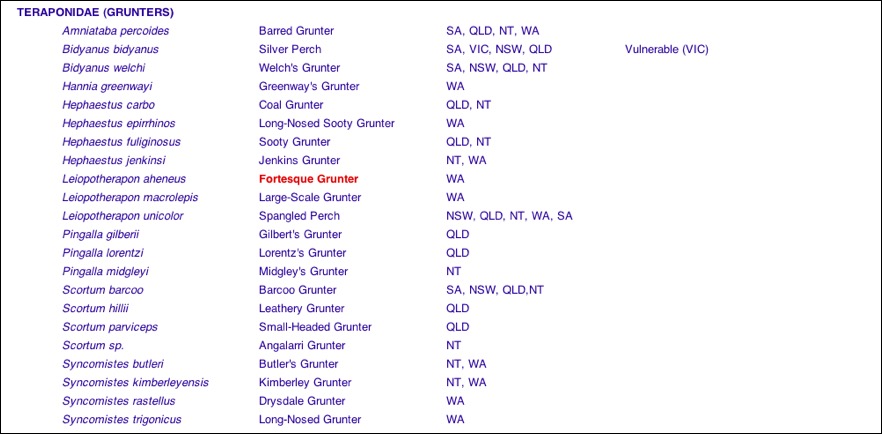
TOM BYRON PUBLISHERS PTY LTD
Australian Scuba Diving Guide Books

Camp Cove: Camp Cove dive site is situated north of the beach along the shoreline to Lady Jane Beach. It's a popular site for scuba diving schools and beginners. The best time to dive this location is on a high tide, diver stands a good chance of having reasonably clear water. Enter the dive site alongside the old wharf and swim in a northerly direction (to your right hand side) along the reef edge toward Lady Jane Beach. Along the way you will encounter many interesting sea creatures-baby sea horses, numerous mados, small bream and snapper, some blue groper, fortesques and weedy sea dragons, plus numerous other macro creatures. Stay close to shore and do not surface too far out into the harbour because sail and motor boats pass close to shore.
(www.netspace.net.au)
Red Rockcod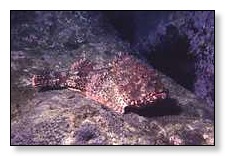
Beautiful and dangerous. Red Rockcod are a member of the scorpionfish family which includes a number of species including Stonefish and Fortesques. Members of this family have poisonous spines that can inflict considerable pain and distress to the victim. If a limb is affected the limb should be immersed in warm water to sooth the pain while medical help is sought (seek confirmation that this is the currently accepted treatment before applying). On a recent dive I found a Rockcod with a fishing hook lodged in it's mouth and some 10-15 metres of fishing line still attached. I was able to cut the line but the hook was imbedded to deep to remove. Barbless hooks are available which may help prevent this problem. It is not unusual to find fish in this state and on another dive I found a large Black Ray with thick rope tied through it's gills. Apparently fishermen put rope through the gills to make it easier to throw the rays overboard when caught in nets, the responsible fishermen loop the rope so it comes loose. I now carry sheers to cut line or rope (caution many rays have tail spines which may inflict severe injury and should be treated with care).
Notesthes robusta
Family Scorpaenidae
Joan O'Connor
Introduction
The Bullrout (Notesthes robusta) is a member of the family Scorpaenidae and is found in estuaries along the eastern seaboard of Australia (Cameron and Endean 1966). This species causes severe and debilitating pain through the secretion of venom from twin venom glands associated with spines in the dorsal, ventral and anal fins (Grant 1978). Envenomation takes place when the spines puncture flesh, when the fish is stepped on, or when anglers attempt to disengage it from nets or lines. The resultant pain is described as intense and recommended treatments include the application of heat, administration of local anesthetics and analgesics with some of the victims requiring complete sedation in hospital (Sutherland 1983). Current literature is mainly descriptive of the fish and the painful effects of envenomation. Little, if any biochemical assessment has been carried out, consequently venom constituents are poorly understood at this time.
The family Scorpaenidae includes some of the most dangerous fish known (Kizer et al. 1985) and they are described by (Edmonds 1989) as resembling the perch and likened by (Keegan and Macfarlane 1963) to the Sea Bass. They have a characteristically large armoured head with sharp venomous spines on the fins. The number of spines in the fin areas vary from 11-17 and these become erect when the fish is aroused or threatened (Edmonds 1984). These fish vary in both form and colouration taking on the predominant colours of their environment. This means Scorpaenidae in tropical waters display brilliant reds, blues and yellows, such as the Butterfly cod - and those fish who inhabit rivers and estuaries such as N. Robusta display drab dark colours (Frey 1994). Known species include : Stonefish, Fortesque, Lionfish, Firefish, and the Rock Cod.
Eastern Fortescue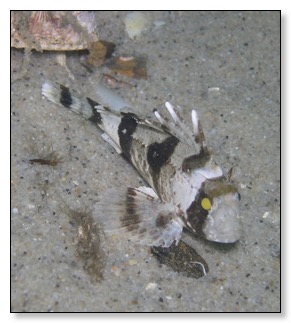
(http://www.underwater-photography.info)
Marine Envenomations
...There are lots of venomous creatures in Australia. This is intended to be a quick reference to the management of lifethreatening envenomations from these creatures...
Venom Actions
Locally acting toxins
Marine venoms commonly cause severe pain (stonefish, ray and fortescue in particular), and, if severe, ischaemia, cyanosis and necrosis.
Venomous Fish Stings and Stingray Spine Injuries
Resources for this page include "Dangerous Marine Animals of the Indo-Pacific Region" (Carl Edmonds, Wedneil Publications, 1978) and more recently "Venomous and Poisonous Marine Animals" (Williamson, Fenner & Burnett, UNSW Press, 1996), and numerous articles from the Medical Journal of Australia.
Non-tropical venomous fish in Australia inlcude catfish, stingrays and the fortescue.
(unimelb.edu)
